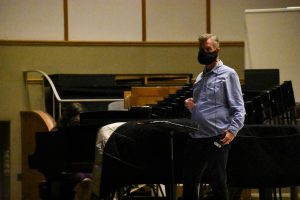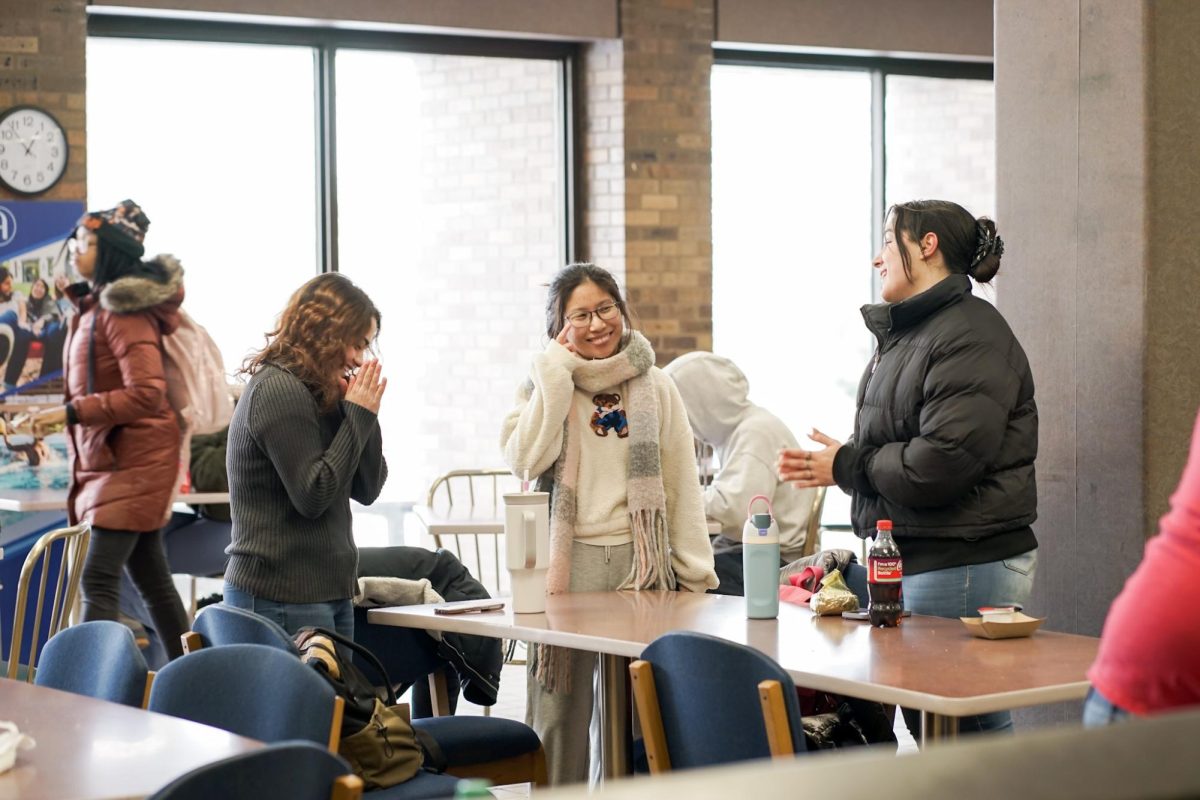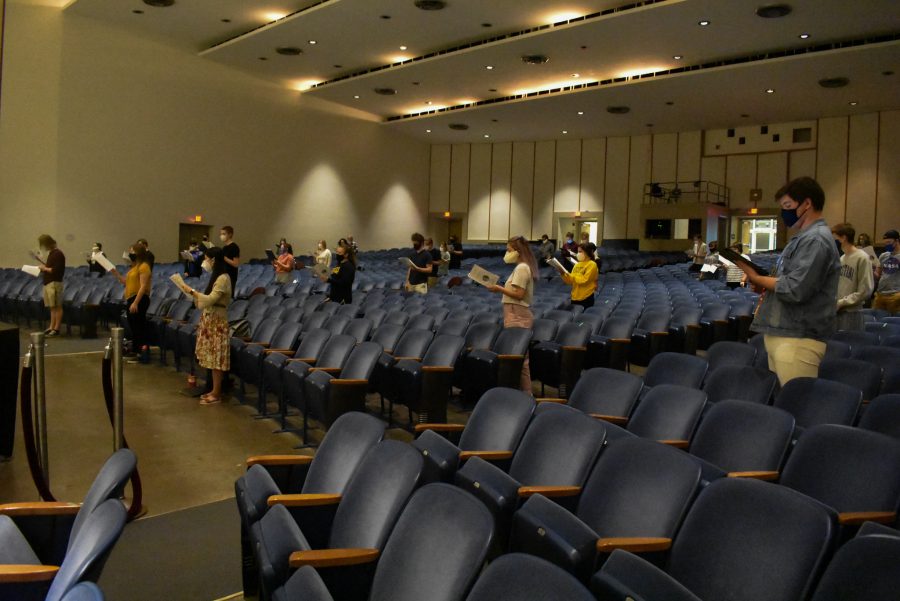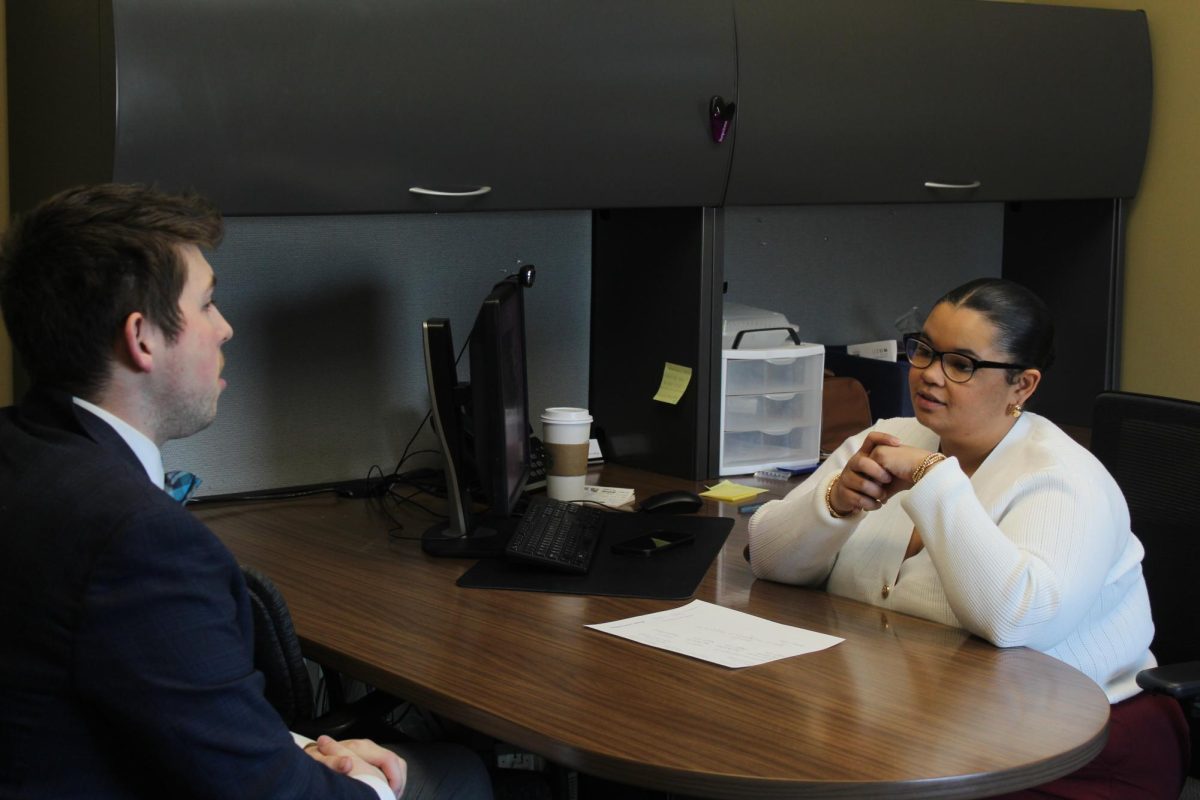Photo above: Augustana’s choir group spread out to remain socially distant during practice at Centennial Hall on Thursday, October 8th, 2020. Photo by Chris Ferman.
In choir, students can stand together as one and create a beautiful sound. With a pandemic going on, choir at Augustana looks a bit different. It’s spaced out, stressful and separated into small practice segments. Even with restrictions in place, however, singers haven’t lost their love for music.
“There’s so much information out there about how dangerous it is to sing,” Jon Hurty, the director of choral activities, said. “I was very concerned to make sure that the students felt what we were doing was an appropriate way to approach singing together.”
Choir students felt uncertain about the semester before practices began. Some were unsure about participating in the ensemble, and a few ultimately decided not to.
“I’m glad that I still get to sing in an ensemble because it’s difficult during these times and Augie’s been doing better than a lot of schools with restrictions,” AJ Weber, junior, said.
“Before we came to campus I was really hesitant about doing choir,” Anna Triska, junior, said. “I’m surprised with how well it’s worked.”
The department worked very hard to put precautions in place for the choir program to be this successful. Before, students were able to stand so close they could practically hold hands. This proximity made blending and tuning easy, as singers were able to hear those around them clearly.
Physical closeness was also a major part of bonding with other choir members. The Jenny Lind Choir previously did back massages every day during their warm-ups. Small talk happened easily in between songs. If a student forgot their music, sharing with the person next to them wouldn’t be questioned at all. These small moments gave students daily chances to get to know the people with whom they are making music.
Now, students have to sing six feet apart with masks on. Practice length has also changed. Instead of singing for an hour and fifteen minutes straight, students can only sing for thirty minutes at a time with a fifteen minute break in between.
A lot of work and research was put into making the choir restrictions.

“We had been combining a lot of information,” Hurty said. “We were getting information from the Augie Strong group and there was a big study that was being done and we were taking recommendations from that into account.”
Choirs are unable to sing all together in the rooms they used to sing in. They must sing either in larger rooms (Centennial or Wallenberg) when they are all together, or smaller rooms (Potter or Larson in Bergendoff) when they are in small sections.
“When we rehearse in Centennial we’re three rows apart and seven seats apart from everyone, we wear masks, we’re all in the audience.” Weber said .
This space ensures more open airflow, which is more COVID-19 resistant. Because of these room changes, the three different choir ensembles have had to coordinate with scheduling.
“Normally one of the groups would be assigned to one room, now we are in this constant rotation so that every choir has the opportunity to be together as a large group as well as in smaller groups,” Hurty said .
“The scheduling was a little difficult at first,” Bradley Heinrichs, senior, said. “But now that we’re in the swing of things people understand where they need to be and we’re taking it as a challenge to keep working harder.”
These regulations have not been impossible, and while many students are grateful choir is available, there are obviously new difficulties for students. Masks especially do not make singing very easy.
“It muffles the sound, and it’s harder to hear yourself annunciate. When you take a big breath you get cloth in your mouth,” Weber said.
Luckily, singers’ masks are going to be purchased for students. These special masks are longer than normal masks and create space for students to breath and project their voices.
“We’re supposed to get singers’ masks in a couple weeks,” Weber said. “An anonymous donor gave money to get the entire choral program singers’ masks.”
While students have admitted to these masks making them look like ducks, they do help a great deal with singing. The department is very grateful for this donation, as they did not want to require purchase of the expensive singing masks.
Being far apart in distance with masks on changed how the choir has sounded as a whole. It doesn’t bring the same learning experience as being close.
“We’re used to being right next to each other. As a vocalist, you learn how to blend your voice with the person next to you. Getting those moments where you’re actually clicking together is a lot more scarce than usual,” Triska said.
“People were timid about singing on their own,” Hurty said. “The changes have been dramatic in the last couple of weeks as we’ve been together.”
Being far away from others has pushed students into being more aware of the way they are singing. This has made singers more confident and allowed them to become determined in making everything work.

“I’ve become more aware of my individual sound, and that didn’t happen last year. That has been really eye-opening. I’ve become more in tune with my own voice this year than previously.” Triska said.
Emotionally, students have felt it is sometimes harder to bond with new members and choir as a whole due to distance. Augie Choir usually has a retreat before rehearsals start, but due to COVID-19, this has not been possible.
Certain aspects of bonding come easier, however, as students can relate to one another with the strange experiences they have had these past few months.
“This year with all of us experiencing the same emotions, it’s almost easier to find those similarities with one another and to not be scared of connecting with one another because there’s so much to talk about.” Triska said.
While things have been harder, it is clear that students need choir more than ever this year. Despite all of the changes, singing has added normalcy into students’ strange college experience and has given them something to work towards together as one.
“Even though the choir is different, it still brings the same feelings, and that’s what I needed this year,” Triska said .
“We all have a collective drive to keep this going because we wouldn’t be there working every day as hard as we are if we didn’t want to be,” Heinrichs said.
The students and department are very proud of what they have accomplished so far. As Jon Hurty conducts Augie Choir, he is very impressed with the way his students have been able to keep pieces of the bond they once had.
“It’s a sign of the resilience of the kind of students that we have here that are willing to do what it takes so that we can do what we love.” Hurty said
Changes have been difficult, but not impossible. It has taken choir students a couple of weeks to get used to changes in the program, but they eventually were able to overcome uncertainty and do the best they can with what they have.
Weber, a vocal performance and music education major, looks forward to staying safe and singing responsibly in hopes that choir will return to normal shortly.
“I’m just glad to still be singing and I’m excited for when we can all be together one foot apart as opposed to six feet,” Weber said.
Additional reporting by Carly Davis











































































































Cecilia Herdegen • Oct 21, 2020 at 11:17 am
Thank you for sharing these experiences during this odd time, and keep making your beautiful music together! Our daughter’s four years singing at Augustana created some of our best memories there.